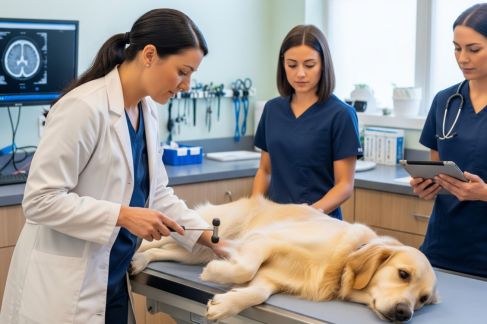When a beloved dog begins to lose coordination, struggle to walk, or experience seizures, it can be heartbreaking and confusing for pet owners. While some neurological problems can be managed with medication and therapy, others may require surgical intervention.
In Chesapeake, many veterinary specialists perform advanced neurosurgical procedures to treat spinal and brain conditions in dogs. Understanding the signs that your pet might need neurosurgery can help you take action early and improve their chances of recovery.
What Is Neurosurgery in Dogs?
Neurosurgery in dogs focuses on correcting problems in the brain, spinal cord, and nerves that cannot be resolved through conservative treatment. These surgeries are typically performed by a veterinary neurologist or a surgeon with specialized training. The goal is to relieve pressure on the nervous system, remove abnormal growths, or repair damaged structures to restore mobility and function. Common neurosurgical procedures in Chesapeake include spinal decompression for intervertebral disc disease (IVDD), removal of brain tumors, and stabilization of spinal fractures.
Why Neurosurgery May Be Needed
A dog may need neurosurgery when a condition causes severe or worsening neurological signs that do not respond to medication or physical therapy. Common reasons include:
- Herniated or ruptured discs that compress the spinal cord
- Spinal trauma or fractures caused by accidents or falls
- Brain tumors that affect normal neurological function
- Congenital abnormalities such as malformations in the spine or skull
- Infections or abscesses that cause pressure buildup in the brain or spinal cord
- Cysts or fluid accumulation leading to compression of nerve tissues
Neurosurgery is often the best option to prevent permanent damage and help the dog regain movement and comfort.
Early Signs of Neurological Trouble
Recognizing neurological symptoms early is crucial. Dogs in Chesapeake that frequently play outdoors, jump off furniture, or are prone to certain genetic conditions may develop symptoms suddenly or gradually. Warning signs include:
- Weakness or stiffness in the legs
- Difficulty standing, walking, or climbing stairs
- Dragging the paws or knuckling over while walking
- Sudden loss of balance or falling to one side
- Head tilt, circling, or disorientation
- Unexplained crying or pain when moving
- Loss of bladder or bowel control
- Seizures, tremors, or twitching
- Sudden vision loss or abnormal eye movements
If these symptoms appear and do not improve within 24–48 hours, it’s essential to seek veterinary evaluation immediately.
Conditions That Commonly Require Neurosurgery
Certain neurological conditions are more likely to lead to surgery, depending on severity and progression. In Chesapeake, veterinary neurologists frequently see the following cases:
Intervertebral Disc Disease (IVDD)
This is one of the most common causes of spinal surgery in dogs. When a disc ruptures or slips, it compresses the spinal cord, causing pain, weakness, or paralysis.
- Early-stage IVDD may respond to rest and anti-inflammatory medication.
- Advanced cases often require surgical decompression to relieve pressure and restore movement.
Spinal Trauma or Fracture
Dogs injured in accidents, falls, or rough play can suffer from spinal fractures or dislocations.
- Neurosurgery may be needed to realign and stabilize the spine using screws, pins, or plates.
- Prompt surgical care can prevent permanent paralysis.
Brain Tumors
Tumors can grow in or around the brain, affecting coordination, vision, and behavior.
- Symptoms include seizures, personality changes, and loss of balance.
- Neurosurgery can remove or reduce the tumor, followed by medication or radiation therapy.
Wobbler Syndrome
Common in large breeds like Dobermans and Great Danes, this condition results from spinal compression in the neck area.
- Dogs may have an unsteady gait or difficulty raising their heads.
- Surgery helps relieve pressure and stabilize the cervical vertebrae.
Hydrocephalus
In young dogs, fluid accumulation in the brain can cause swelling and neurological signs.
- Neurosurgery may involve placing a shunt to drain excess fluid and reduce pressure.
How a Veterinary Neurologist Determines the Need for Surgery
Before recommending surgery, a veterinary neurologist conducts a thorough evaluation to locate the problem and assess its severity. The diagnostic process in Chesapeake clinics often includes:
- Neurological examination to identify which part of the nervous system is affected
- MRI or CT scans to visualize spinal or brain structures in detail
- Spinal tap (CSF analysis) to detect inflammation or infection
- Electrodiagnostic tests to assess nerve and muscle function
Based on results, the neurologist will determine whether surgery or medical management offers the best outcome.
What to Expect Before and After Surgery
If neurosurgery is recommended, the veterinarian will explain the procedure, potential risks, and recovery expectations.
Before surgery:
- Your dog may need to fast and undergo pre-anesthetic blood work.
- The surgeon will review imaging results to plan the procedure precisely.
After surgery:
- Dogs often stay in the hospital for observation and pain control.
- Rehabilitation therapies such as hydrotherapy and physiotherapy begin once healing starts.
- Regular follow-up visits ensure the spine or brain is healing correctly.
- Most dogs gradually regain mobility and strength with proper care and rehabilitation.
Post-Surgery Recovery and Home Care
Recovery time varies depending on the condition and procedure, but most dogs improve significantly within weeks to months. Pet owners in Chesapeake should follow these guidelines:
- Limit physical activity and provide a quiet recovery space.
- Use harnesses or slings for support during walking.
- Administer medications as prescribed to manage pain and inflammation.
- Attend scheduled therapy sessions for muscle rebuilding and coordination.
- Monitor for any signs of infection, weakness, or discomfort and report them promptly.
Consistent care at home combined with follow-up visits greatly enhances recovery outcomes.
When to Seek Immediate Help
Some neurological emergencies require immediate veterinary attention. Contact a vet or emergency clinic in Chesapeake right away if your dog shows:
- Sudden inability to walk or stand
- Continuous or repeated seizures
- Loss of consciousness
- Uncontrolled pain or crying out
- Rapid deterioration of coordination or strength
Early action can prevent irreversible nerve damage and may save your dog’s life.
Conclusion
Neurosurgery may sound intimidating, but for many dogs, it offers the best chance to regain normal function and quality of life. In Chesapeake, veterinary neurologists are equipped with advanced imaging tools, surgical techniques, and rehabilitation programs to handle complex neurological conditions. By recognizing the warning signs early and seeking expert care, pet owners can ensure their dogs receive timely treatment, improving both comfort and long-term recovery.





